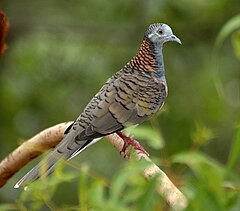Geopelia
Geopelia – rodzaj ptaków z podrodziny treronów (Raphinae) w rodzinie gołębiowatych (Columbidae).
| Geopelia[1] | |||
| Swainson, 1837[2] | |||
 Przedstawiciel rodzaju – gołąbek duży (G. humeralis) | |||
| Systematyka | |||
| Domena | |||
|---|---|---|---|
| Królestwo | |||
| Typ | |||
| Podtyp | |||
| Gromada | |||
| Podgromada | |||
| Infragromada | |||
| Rząd | |||
| Rodzina | |||
| Podrodzina | |||
| Rodzaj |
Geopelia | ||
| Typ nomenklatoryczny | |||
|
Geopelia lineata Swainson, 1837 (= Columba striata Linnaeus, 1766) | |||
| Synonimy | |||
|
| |||
| Gatunki | |||
| |||
Zasięg występowania edytuj
Rodzaj obejmuje gatunki występujące w Azji Południowo-Wschodniej i Australazji[6].
Morfologia edytuj
Długość ciała 19–30 cm; masa ciała 28–150 g[7].
Systematyka edytuj
Etymologia edytuj
- Geopelia: gr. γεω- geō- „ziemny-”, od γη gē „ziemia grunt”; πελεια peleia „gołąb”[8].
- Stictopeleia: gr. στικτος stiktos „cętkowany, kropkowany”, od στιζω stizō „tatuować”; πελεια peleia „gołąb”[9]. Gatunek typowy: Columba cuneata Latham, 1801.
- Tomopeleia: gr. τομος tomos „ostry, tnący”, od τεμνω temnō „ciąć”; πελεια peleia „gołąb”[10]. Gatunek typowy: Columba maugeus Temminck, 1809.
- Erythrauchaena: epitet gatunkowy Columba erythrauchen Wagler, 1827; οινας oinas, οιναδος oinados „gołąb”[11]. Gatunek typowy: Columba humeralis Temminck, 1821.
- Chrysauchoena: gr. χρυσος khrusos „złoto”; αυχην aukhēn, αυχενος aukhenos „szyja, gardło”; οινας oinas, οιναδος oinados „gołąb”[12]. Gatunek typowy: Columba humeralis Temminck, 1821.
Podział systematyczny edytuj
Do rodzaju należą następujące gatunki[13]:
- Geopelia cuneata – gołąbek diamentowy
- Geopelia striata – gołąbek zebrowany
- Geopelia placida – gołąbek łuskowany
- Geopelia maugeus – gołąbek falisty
- Geopelia humeralis – gołąbek duży
Przypisy edytuj
- ↑ Geopelia, [w:] Integrated Taxonomic Information System (ang.).
- ↑ W. Swainson: On the natural history and classification of birds. Cz. 2. London: John Taylor, 1837, s. 348. (ang.).
- ↑ a b H.G.L. Reichenbach: Avium systema naturale. Das natürliche system der vögel mit hundert tafeln grösstentheils original-abbildungen der bis jetzt entdecken fast zwölfhundert typischen formen. Vorlaüfer einer iconographie der arten der vögel aller welttheile. Dresden und Leipzig: Expedition der vollständigsten naturgeschichte, 1850, s. xxv. (niem.).
- ↑ Ch.L. Bonaparte: Conspectus generum avium. T. 2. Lugduni Batavorum: Apud E.J. Brill, 1857, s. 93. (łac.).
- ↑ Ch.L. Bonaparte. Coup d’œil sur les Pigeons (sixième et dernière partie). „Comptes rendus hebdomadaires de l’Académie des Sciences”. 40, s. 210, 1855. (fr.).
- ↑ F. Gill, D. Donsker & P. Rasmussen (red.): Pigeons. IOC World Bird List (v10.2). [dostęp 2020-08-08]. (ang.).
- ↑ L.F. Baptista, P.W. Trail & H.M. Horblit: Family Columbidae (Pigeons and Doves). W: J. del Hoyo, A. Elliott & J. Sargatal: Handbook of the Birds of the World. Cz. 4: Sandgrouse to Cuckoos. Barcelona: Lynx Edicions, 1997. ISBN 84-87334-22-9. (ang.).
- ↑ The Key to Scientific Names ↓, Geopelia [dostęp 2019-07-20].
- ↑ The Key to Scientific Names ↓, Stictopeleia [dostęp 2019-07-20].
- ↑ The Key to Scientific Names ↓, Tomopeleia [dostęp 2019-07-20].
- ↑ The Key to Scientific Names ↓, Erythrauchaena [dostęp 2019-07-20].
- ↑ The Key to Scientific Names ↓, Chrysauchoena [dostęp 2019-07-20].
- ↑ Systematyka i nazwy polskie za: P. Mielczarek & M. Kuziemko: Podrodzina: Raphinae Wetmore, 1930 (1835) - trerony (wersja: 2019-07-21). [w:] Kompletna lista ptaków świata [on-line]. Instytut Nauk o Środowisku Uniwersytetu Jagiellońskiego. [dostęp 2020-08-08].
Bibliografia edytuj
- The Key to Scientific Names, J.A. Jobling (red.), [w:] Birds of the World, S.M. Billerman et al. (red.), Cornell Lab of Ornithology, Ithaca (ang.).